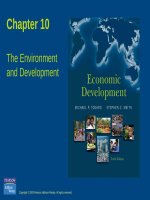Lecture biology (6e) chapter 10 campbell, reece
Bạn đang xem bản rút gọn của tài liệu. Xem và tải ngay bản đầy đủ của tài liệu tại đây (1.1 MB, 70 trang )
CHAPTER 10 PHOTOSYNTHESIS
Section A: Photosynthesis in Nature
1. Plants and other autotrophs are the producers of the biosphere
2. Chloroplasts are the site of photosynthesis in plants
Copyright © 2002 Pearson Education, Inc., publishing as Benjamin Cummings
Introduction
• Life on Earth is solar powered.
• The chloroplasts of plants use a process called
photosynthesis to capture light energy from the sun
and convert it to chemical energy stored in sugars
and other organic molecules.
Copyright © 2002 Pearson Education, Inc., publishing as Benjamin Cummings
1. Plants and other autotrophs are the
producers of the biosphere
• Photosynthesis nourishes almost all of the living
world directly or indirectly.
• All organisms require organic compounds for energy and
for carbon skeletons.
• Autotrophs produce their organic molecules from
CO2 and other inorganic raw materials obtained from
the environment.
• Autotrophs are the ultimate sources of organic compounds
for all nonautotrophic organisms.
• Autotrophs are the producers of the biosphere.
Copyright © 2002 Pearson Education, Inc., publishing as Benjamin Cummings
• Autotrophs can be separated by the source of
energy that drives their metabolism.
• Photoautotrophs use light as the energy source.
• Photosynthesis occurs in plants, algae, some other
protists, and some prokaryotes.
• Chemoautotrophs harvest energy from oxidizing
inorganic substances,
including sulfur and
ammonia.
• Chemoautotrophy is
unique to bacteria.
Fig. 9.1
Copyright © 2002 Pearson Education, Inc., publishing as Benjamin Cummings
• Heterotrophs live on organic compounds
produced by other organisms.
• These organisms are the consumers of the biosphere.
• The most obvious type of heterotrophs feed on plants
and other animals.
• Other heterotrophs decompose and feed on dead
organisms and on organic litter, like feces and fallen
leaves.
• Almost all heterotrophs are completely dependent on
photoautotrophs for food and for oxygen, a byproduct
of photosynthesis.
Copyright © 2002 Pearson Education, Inc., publishing as Benjamin Cummings
2. Chloroplasts are the sites of
photosynthesis in plants
• Any green part of a plant has chloroplasts.
• However, the leaves are the major site of
photosynthesis for most plants.
• There are about half a million chloroplasts per square
millimeter of leaf surface.
• The color of a leaf comes from chlorophyll, the
green pigment in the chloroplasts.
• Chlorophyll plays an important role in the absorption of
light energy during photosynthesis.
Copyright © 2002 Pearson Education, Inc., publishing as Benjamin Cummings
• Chloroplasts are found mainly in mesophyll cells
forming the tissues in the interior of the leaf.
• O2 exits and CO2 enters the leaf through microscopic
pores, stomata, in the leaf.
• Veins deliver water
from the roots and
carry off sugar from
mesophyll cells to
other plant areas.
Fig. 10.2
Copyright © 2002 Pearson Education, Inc., publishing as Benjamin Cummings
• A typical mesophyll cell has 30-40 chloroplasts, each
about 2-4 microns by 4-7 microns long.
• Each chloroplast has two membranes around a
central aqueous space, the stroma.
• In the stroma are
membranous sacs,
the thylakoids.
• These have an internal
aqueous space, the
thylakoid lumen or
thylakoid space.
ã Thylakoids may be stacked
into columns called grana.
Copyright â 2002 Pearson Education, Inc., publishing as Benjamin Cummings
Fig. 10.2
CHAPTER 10 PHOTOSYNTHESIS
Section A1: The Pathways of Photosynthesis
1. Evidence that chloroplasts split water molecules enabled researchers to
track atoms through photosynthesis
2. The light reaction and the Calvin cycle cooperate in converting light energy
to the chemical energy of food: an overview
3. The light reactions convert solar energy to the chemical energy of ATP and
NADPH: a closer look
Copyright © 2002 Pearson Education, Inc., publishing as Benjamin Cummings
1. Evidence that chloroplasts split water
molecules enabled researchers to track
atoms through photosynthesis
• Powered by light, the green parts of plants produce
organic compounds and O2 from CO2 and H2O.
• Using glucose as our target product, the equation
describing the net process of photosynthesis is:
• 6CO2 + 6H2O + light energy -> C6H12O6 + 6O2
• In reality, photosynthesis adds one CO2 at a time:
• CO2 + H2O + light energy -> CH2O + O2
ã CH2O represents the general formula for a sugar.
Copyright â 2002 Pearson Education, Inc., publishing as Benjamin Cummings
• One of the first clues to the mechanism of
photosynthesis came from the discovery that the O 2
given off by plants comes from H2O, not CO2.
• Before the 1930s, the prevailing hypothesis was that
photosynthesis occurred in two steps:
• Step 1: CO2 -> C + O2 and Step 2: C + H2O -> CH2O
• C.B. van Niel challenged this hypothesis.
• In the bacteria that he was studying, hydrogen sulfide
(H2S), not water, is used in photosynthesis.
• They produce yellow globules of sulfur as a waste.
• Van Niel proposed this reaction:
• CO2 + 2H2S -> CH2O + H2O + 2S
Copyright © 2002 Pearson Education, Inc., publishing as Benjamin Cummings
• He generalized this idea and applied it to plants,
proposing this reaction for their photosynthesis.
• CO2 + 2H2O -> CH2O + H2O + O2
• Other scientists confirmed van Niel’s hypothesis.
• They used 18O, a heavy isotope, as a tracer.
• They could label either CO2 or H2O.
• They found that the 18O label only appeared if water
was the source of the tracer.
• Essentially, hydrogen extracted from water is
incorporated into sugar and the oxygen released to
the atmosphere (where it will be used in
respiration).
Copyright © 2002 Pearson Education, Inc., publishing as Benjamin Cummings
• Photosynthesis is a redox reaction.
• It reverses the direction of electron flow in respiration.
• Water is split and electrons transferred with H+
from water to CO2, reducing it to sugar.
• Polar covalent bonds (unequal sharing) are converted to
nonpolar covalent bonds (equal sharing).
• Light boosts the potential energy of electrons as they
move from water to sugar.
Fig. 10.3
Copyright © 2002 Pearson Education, Inc., publishing as Benjamin Cummings
2. The light reactions and the Calvin cycle
cooperate in converting light energy to
chemical energy of food: an overview
• Photosynthesis is two processes, each with multiple
stages.
• The light reactions convert solar energy to chemical
energy.
• The Calvin cycle incorporates CO2 from the
atmosphere into an organic molecule and uses
energy from the light reaction to reduce the new
carbon piece to sugar.
Copyright © 2002 Pearson Education, Inc., publishing as Benjamin Cummings
• In the light reaction light energy absorbed by
chlorophyll in the thylakoids drives the transfer of
electrons and hydrogen from water to NADP+
(nicotinamide adenine dinucleotide phosphate),
forming NADPH.
• NADPH, an electron acceptor, provides energized
electrons, reducing power, to the Calvin cycle.
• The light reaction also generates ATP by
photophosphorylation for the Calvin cycle.
Copyright © 2002 Pearson Education, Inc., publishing as Benjamin Cummings
Fig. 10.4
Copyright © 2002 Pearson Education, Inc., publishing as Benjamin Cummings
• The Calvin cycle is named for Melvin Calvin who,
with his colleagues, worked out many of its steps
in the 1940s.
• It begins with the incorporation of CO2 into an
organic molecule via carbon fixation.
• This new piece of carbon backbone is reduced with
electrons provided by NADPH.
• ATP from the light reaction also powers parts of
the Calvin cycle.
• While the light reactions occur at the thylakoids,
the Calvin cycle occurs in the stroma.
Copyright © 2002 Pearson Education, Inc., publishing as Benjamin Cummings
3. The light reactions convert solar energy
to the chemical energy of ATP and
NADPH: a closer look
• The thylakoids convert light energy into the
chemical energy of ATP and NADPH.
• Light, like other form of electromagnetic energy,
travels in rhythmic waves.
• The distance between crests of electromagnetic
waves is called the wavelength.
• Wavelengths of electromagnetic radiation range from less
than a nanometer (gamma rays) to over a kilometer (radio
waves).
Copyright © 2002 Pearson Education, Inc., publishing as Benjamin Cummings
• The entire range of electromagnetic radiation is the
electromagnetic spectrum.
• The most important segment for life is a narrow
band between 380 to 750 nm, visible light.
Fig. 10.5
Copyright © 2002 Pearson Education, Inc., publishing as Benjamin Cummings
• While light travels as a wave, many of its
properties are those of a discrete particle, the
photon.
• Photons are not tangible objects, but they do have fixed
quantities of energy.
• The amount of energy packaged in a photon is
inversely related to its wavelength.
• Photons with shorter wavelengths pack more energy.
• While the sun radiates a full electromagnetic
spectrum, the atmosphere selectively screens out
most wavelengths, permitting only visible light to
pass in significant quantities.
Copyright © 2002 Pearson Education, Inc., publishing as Benjamin Cummings
• When light meets matter, it may be reflected,
transmitted, or absorbed.
• Different pigments absorb photons of different
wavelengths.
• A leaf looks green
because chlorophyll,
the dominant pigment,
absorbs red and blue
light, while transmitting
and reflecting green light.
Fig. 10.6
Copyright © 2002 Pearson Education, Inc., publishing as Benjamin Cummings
• A spectrophotometer measures the ability of a
pigment to absorb various wavelengths of light.
• It beams narrow wavelengths of light through a solution
containing a pigment and measures the fraction of light
transmitted at
each wavelength.
• An absorption
spectrum plots a
pigment’s light
absorption versus
wavelength.
Fig. 10.7
Copyright © 2002 Pearson Education, Inc., publishing as Benjamin Cummings
• The light reaction can perform work with those
wavelengths of light that are absorbed.
• In the thylakoid are several pigments that differ in
their absorption spectrum.
• Chlorophyll a, the dominant pigment, absorbs best in
the red and blue wavelengths, and least in the green.
ã Other pigments
with different
structures have
different
absorption
spectra.
Fig. 10.8a
Copyright â 2002 Pearson Education, Inc., publishing as Benjamin Cummings
• Collectively, these photosynthetic pigments
determine an overall action spectrum for
photosynthesis.
• An action spectrum measures changes in some measure
of photosynthetic activity (for example, O2 release) as
the wavelength is varied.
Fig. 10.8b
Copyright © 2002 Pearson Education, Inc., publishing as Benjamin Cummings
• The action spectrum of photosynthesis was first
demonstrated in 1883 by an elegant experiment by
Thomas Engelmann.
• In this experiment, different segments of a filamentous
alga were exposed to different wavelengths of light.
• Areas receiving wavelengths favorable to
photosynthesis should produce excess O2.
• Engelmann used the
abundance of aerobic
bacteria clustered
along the alga as a
measure of O2
production.
Fig. 10.8c
Copyright © 2002 Pearson Education, Inc., publishing as Benjamin Cummings









